October 11, 2024
Air Date: October 11, 2024
FULL SHOW
SEGMENTS
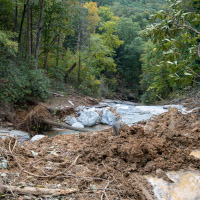
Hurricanes’ Hidden Toll
View the page for this story
New research published in Nature suggests that initial death tolls only account for a tiny fraction of the mortality that can be linked to hurricanes. On average, each tropical storm or hurricane contributes to 7,000 to 11,000 excess deaths as long as 15 years afterwards. Lead author Rachel Young of UC Berkeley joins Host Paloma Beltran to explain how societal disruptions can bring these long-term effects. (10:56)

Loading the Hurricane Dice
View the page for this story
Unusually warm waters in the Gulf of Mexico helped fuel the rapid intensification of Hurricanes Helene and Milton. Meteorologist Sean Sublette explains to Host Jenni Doering that as humans continue to pump climate-warming greenhouse gases into the atmosphere, we are loading the dice for stronger storms. (10:04)

Hiking on Wheels
/ Jenni Doering & El WilsonView the page for this story
Physical disabilities can make getting outside more challenging, but adaptive devices and accessible trails can transform lives. Producer El Wilson, who has cerebral palsy, and producer Jenni Doering test an offroad wheelchair and meet a woman who has been able to reclaim the joy and freedom of hiking since becoming disabled. (09:48)

Conversations with Dogs
View the page for this story
New research into word comprehension in dogs suggests that with training and special equipment, man’s best friend can in fact understand specific words and reply. Senior author Federico Rossano is a cognitive scientist at UC San Diego and joins Living on Earth’s Steve Curwood to explain why motivation appears to be one of the most important factors driving this ability for dogs to converse in human speech. (15:47)
Show Credits and Funders
Show Transcript
241011 Transcript
HOSTS: Paloma Beltran, Jenni Doering
GUESTS: Rachel Young, Sean Sublette, Amy Sugihara, Karen Foster, and Federico Rossano.
REPORTERS: Paloma Beltran, Jenni Doering, El Wilson, Steve Curwood.
[THEME]
DOERING: From PRX – this is Living on Earth.
[THEME]
DOERING: I’m Jenni Doering.
BELTRAN: And I’m Paloma Beltran.
Hurricanes like Milton and Helene take a toll that lasts for years.
YOUNG: We find that per storm, there's between seven and 11,000 excess deaths, which is 300 times greater than the official counts of direct deaths. And these results really highlight that hurricanes and tropical storms are a much greater mortality burden than anyone previously thought.
DOERING: Also, research suggests we really can talk to man’s best friend.
ROSSANO: You don't need to have a PhD to be able to have conversations with people so it's more about are you motivated to interact with others and to communicate with your human? What we find is that the dogs who are mainly motivated by praise or play, tend to learn a bit better than the ones who are mainly motivated by food.
DOERING: Those stories and more, this week on Living on Earth—stick around!
[NEWSBREAK MUSIC: Boards of Canada “Zoetrope” from “In A Beautiful Place Out in The Country” (Warp Records 2000)]
[THEME]
Hurricanes’ Hidden Toll

Damage from Hurricane Helene in North Carolina. Overall, initial reports indicate Helene has killed at least 231 people across 6 states, one of the deadliest hurricanes to strike the US mainland in the last 50 years. Ultimate mortality could be 300 times that, the published by Nature research suggests. (Photo: NCDOTcommunications, Wikimedia Commons, CC BY 2.0)
DOERING: From PRX and the Jennifer and Ted Stanley Studios at the University of Massachusetts, Boston, this is Living on Earth. I’m Jenni Doering.
BELTRAN: And I’m Paloma Beltran.
Hurricane Milton spun off deadly tornadoes and cut power to more than 3 million Floridians as it charged across the Florida Peninsula. Tampa dodged the worst-case scenario of massive storm surge, but nearby St. Petersburg experienced over 17 inches of rain. Deaths from Hurricane Milton are still being tallied as we go to air, meanwhile, the official death toll from Hurricane Helene has passed 230. But as devastating as those numbers are, a recent paper published in Nature suggests that these initial death tolls probably account for a fraction of the mortality that can be linked to hurricanes. As many as 3 million excess deaths can be attributed to tropical storms and hurricanes that impacted the US between 1930 and 2015. Lead researcher Rachel Young is an environmental economist and post-doctoral researcher at the University of California, Berkeley, and she joined me to explain the findings.
YOUNG: Yeah, in our paper, we studied 500 tropical storms and hurricanes, which we sort of call tropical cyclones that impacted the United States between 1930 and 2015, and we estimate the long run impact those storms have had on mortality at the state level. And we find that there are persistent effects for up to 15 years, there's elevated rates of mortality for up to 15 years, and we find that per storm there's between 7 and 11,000 excess deaths, which is 300 times greater than the official counts of direct deaths. And these results really highlight that hurricanes and tropical storms are a much greater mortality burden than anyone previously thought.
BELTRAN: And why do mortality rates remain so high even after storms hit?
YOUNG: We can't disentangle all of the different ways that hurricanes impact people's lives that could lead to elevated rates of mortality. We do posit a few hypotheses of what could be going on. In the paper, we have five. I'll just talk through a couple, though. The first, and I think is the sort of most prevalent, is that there are just long run economic impacts that hurt people after these storms. You can imagine that your house is partially destroyed or damaged, and folks have to draw down from their retirement accounts or their savings accounts to pay for repairs to those damages, which may, in turn, mean that in the future, if they have a health care incident, or if you know, they need to go to the hospital for any sort of health care related reason, they might not have as much money to pay for the kind of care that they need compared to what kind of money they would have before the storm. Another potential sort of channel is just that there's massive devastation that can occur after these events, huge amounts of damage, and that could drive heightened levels of pollution exposure for individuals. So, a storm comes in, it could destroy a gas station or other kinds of facilities that house a lot of chemicals. We've seen with Helene, some impacts to the sewage systems and massive amounts of raw sewage flowing in the streets. And these kinds of pollution exposures can have long term impacts on people's health outcomes. And then finally, state and local governments have lower budget levels after these storms. You know, they spend a lot of money on repairs for roads and bridges and other kinds of infrastructure, which means that they don't have as much resources to allocate to things, maybe like buying a new wing for a hospital, or other kinds of healthcare related emergency services, which could impact people's healthcare in the long run.
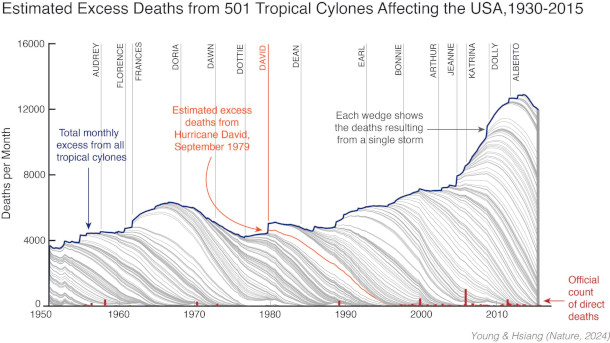
Stacked overlapping excess mortality responses to each storm for all of CONUS (gray lines). Each storm response depicted aggregates state-level responses nationally, accounting for state-level population and adaptation. Official deaths directly resulting from TCs for each month according to NOAA National Hurricane Center and NOAA National Weather Service (red bars). Estimated monthly excess deaths from 501 tropical cyclones (gray lines) and the total (navy blue top line). (Graph: Courtesy of Rachel Marie Young)
BELTRAN: Now, what about age groups? How do death rates differ across age groups?
YOUNG: Yeah. So, one thing we thought was really important is to understand if different kinds of folks are at different levels of risk after a storm. And so, we do go, and we look at a couple of different age bins and look at their differential sensitivities after these storms, and we find that infants and the elderly population are particularly vulnerable. After a hurricane, infants have a much greater mortality risk than, say, folks that are aged between 1 and 44. For the infant result, these are infants that are being born many years after the storm, so they did not physically experience the hurricane or tropical storm themselves. The southeast of the United States has elevated rates of mortality compared to the rest of the country, particularly for infants, and we actually find that tropical cyclones are a major driver of those impacts. These are places and states that are getting hit by tropical cyclones many, many times, and that sort of overall climate of being impacted by tropical cyclones is part of the reason why we're seeing higher rates of mortality in the southeastern states.
BELTRAN: So according to this study, infants who weren't even conceived by the time a hurricane hits are still more likely to die because of it?
YOUNG: Yeah, that's exactly what we see. So, 21 months after the storm, these are infants that are dying that were not in utero, they did not physically experience the hurricane or tropical storms themselves. So you can imagine mothers who are giving birth a few years after the storm, maybe they were paying out of their savings account for repairs to their home, replacing their car, other kinds of things that were damaged during the storm, and so they might not have as much access to different kinds of prenatal care, because they just have less money than they would have if they had not had to pay for those repairs. And so, we think this points to maternal health care that needs to be prioritized in order to help reduce some of these infant sensitivities.
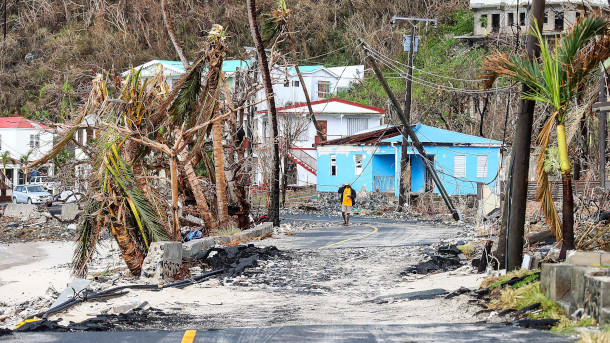
Picture taken in Great Carrot Bay, Puerto Rico showing a local man walking through the devastation and what is left of the coast road in the aftermath of Hurricane Maria . (Photo: Joel Rouse, Wikimedia Commons, Fair Use)
BELTRAN: And how did this study account for race?
YOUNG: So, we are able to look at the different risk of mortality amongst the black population compared to white populations, and we find that black populations are much more sensitive after a storm. They have higher rates of mortality compared to their counterparts in white populations. In fact, their mortality risk is about three times greater than white populations. There's a lot of growing literature and a lot of growing discussions around the differences that black populations face with regards to different kinds of environmental events. There's studies that show that they experience heightened rates of air pollution, because of a history of zoning and public housing in the United States. There's a lot of other systemic reasons why black populations have less access to federal resources after disasters, or just other kinds of public services, and we think a lot of that is sort of tied up in why we see elevated rates of mortality risk for those populations.
BELTRAN: Now this study focuses on the continental US but how does it resonate with, for example, Hurricane Maria, where almost 3000 people in Puerto Rico died directly from the hurricane and it caused extensive damage to the island's infrastructure. I mean, some areas of the island are still recovering to this day.
YOUNG: Yeah, Hurricane Maria and then there was a subsequent study that showed that the deaths that were traceable to hurricane Maria were much greater than the official direct death counts, a lot of it driven by power outages that persisted for months after the storm. And that paper actually really was inspiring to us, and helped show that the way that we think about direct deaths and deaths related to hurricanes might not be quite right, and the study that they did really lent credibility to our sort of estimates of the longer-term impact of hurricanes on an individual's mortality. And they do a great job of tracing out some of the ways in which the hurricane impacted infrastructure, which then impacts people's health.
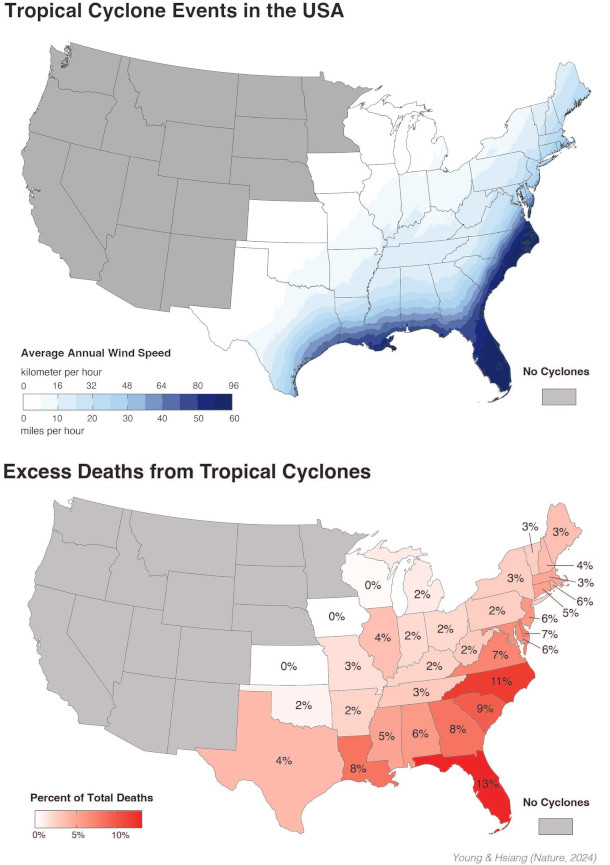
(Top panel): Average annual tropical cyclone maximum wind speed impacting the contiguous US (CONUS), during 1950-2015. (Bottom panel): Estimated average excess mortality traceable to the TC climate by state during 1950–2015. (Graph: Courtesy of Rachel Marie Young)
BELTRAN: You know, Rachel, there are these big hurricanes and tropical storms like Hurricane Katrina, Helene, Maria but what about smaller storms like Hurricane Debbie that hit North Carolina earlier this year?
YOUNG: Yeah, our study, we studied the effects of 500 tropical storms and hurricanes. I expect that most people can't name 500 tropical storms or hurricanes, there are a lot of these storms that are much smaller, that aren't Category 5, that aren't sort of in the news as much. And I think what's important about our findings is that these smaller storms are also impacting communities for a long time. They might not generate as many excess deaths because they have lower wind speeds and lower footprints over the country, but they are also impacting states, and they're driving a lot of those big overall estimates that we find in the study. The 3 million excess deaths is not just from a Katrina or a Sandy it's from the cumulative effects of a lot of small storms and big storms over many, many years.
BELTRAN: Rachel what surprised you most from this study?
YOUNG: The whole study was very surprising to us, like when we initially started this paper, we thought, you know, we knew things about the impact of hurricanes on the economy, and we knew things about how different kinds of environmental events impact long run health, particularly heat waves. We thought that we would see elevated rates of mortality for maybe six months or a year. And when we were doing the analysis, and we saw that the effects were so long, we were really stunned. And we spent many, many years trying to make sure that it wasn't driven by some kind of statistical anomaly. It wasn't an error on our side or an error in the analysis, and we tried every other possible explanation for what could be going on, and ultimately, we found that it was nothing else could explain this elevated mortality rate, except for hurricanes. The whole thing was very, very surprising, and if so, folks are sort of stunned by the magnitude of the effects and the long run impact of these events on human health and mortality, you know, we were there too. We were also very surprised.

Rachel Marie Young is an environmental economist and post-doctoral researcher at the University of California, Berkeley. (Photo: Courtesy of Rachel Marie Young)
BELTRAN: Now, Hurricane Helene caused severe damage across southeastern states, and hurricane Milton just hit Florida. What can government agencies and government officials learn from this study in order to provide the support communities need for recovery?
YOUNG: State and local and federal governments, and especially first responders are doing really heroic work to help people after these events, to rescue folks, to help get them back on their feet and we don't want their efforts to be in vain. Our study really highlights that communities are being impacted far beyond the immediate aftermath of the storm, that these effects can impact them for many, many years and can lead to impacts on their health. And the individuals that are being impacted by these storms 5, 10, years later, likely themselves, cannot connect their elevated mortality risk in the future back to the original storm. And so, we think that our study really highlights that we can't forget about these communities, and that we need to help them get back on their feet as quickly as possible. We need them to get their insurance payouts in a timely manner and get access to the resources from the federal and state and local governments as fast as they can. And that we can't just forget that this happened, that these folks are going to be impacted for a long time. We need to give them support and resources for longer than we previously thought, and hopefully that will ensure that we see lower mortality rates after hurricanes in the future.
BELTRAN: Rachel Young is an environmental economist and postdoctoral researcher at UC Berkeley. Thanks for joining us.
YOUNG: Thank you for having me.
Related links:
- Nature | “Mortality Caused by Tropical Cyclones in the United States”
- Scientific American | “Hurricanes Kill People for Years after the Initial Disaster”
- The Guardian | “Major Storms Contribute to Thousands of Deaths Up to 15 Years Later, Study Finds”
[MUSIC: Red Garland Trio “Stormy Weather” on All Kinds of Weather, Fantasy, Inc.]
DOERING: Coming up, a meteorologist explains why climate change is bringing stronger hurricanes, and it’s not rocket science. That’s just ahead on Living on Earth. Stay tuned!
ANNOUNCER: Support for Living on Earth comes from Sailors for the Sea and Oceana. Helping boaters race clean, sail green and protect the seas they love. More information at sailorsforthesea.org.
[CUTAWAY MUSIC: Red Garland Trio “Stormy Weather” on All Kinds of Weather, Fantasy, Inc.]
Loading the Hurricane Dice
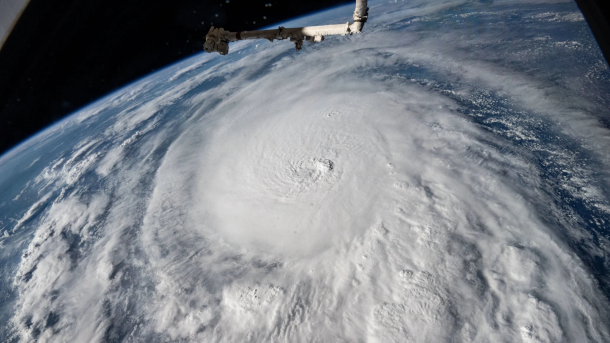
Hurricane Milton as seen from the International Space Station on October 8th. (Photo: Satellite photo, NASA, Wikimedia Commons, Public Domain)
BELTRAN: It’s Living on Earth, I’m Paloma Beltran.
DOERING: And I’m Jenni Doering.
Hurricanes Milton and Helene underwent rapid intensification thanks in part to very warm waters in the Gulf of Mexico. During each storm temps were in the mid to high 80s Fahrenheit, well above the 79 degrees required to feed a hurricane. Warmer waters in the Gulf means there’s more energy to power a storm. And an analysis published by the World Weather Attribution network of scientists pinpointed climate disruption as a key driver of the warm waters that made Helene so catastrophic with intense rainfall and wind. Sean Sublette is a meteorologist who writes for our media partner, Inside Climate News. And he joins me now from Richmond, Virginia to talk about the conditions that led to this one-two punch of storms. Welcome to Living on Earth, Sean.
SUBLETTE: Thank you very much for having me. I appreciate the invitation.
DOERING: So, how unusual is a situation like this for this time of year, two massive hurricanes nearly back-to-back at this point in the fall season?
SUBLETTE: It's unusual, but it's not without precedent. The core of the hurricane season is from mid-August to mid-October, and we're just starting to get toward mid-October now. If we're having this conversation around Halloween, it's probably a little bit different. But in the Gulf of Mexico, the water temperatures are typically in the 80s this time of year, even well before the climate started to warm things. So, to have hurricanes in the Gulf of Mexico is not unusual in and of itself. One of the things I think that most meteorologists kind of gasped at wasn't the fact that we had two of them, but we had two that underwent rapid intensification. And that's something that sounds colloquial, but it has a very strict definition, meaning that the sustained wind speeds, the maximum sustained wind speeds, have to increase by 35 miles per hour in 24 hours. And those thresholds were easily met for both Helene and Milton.
DOERING: Yeah, I saw that hurricane Milton did indeed rapidly intensify. Do you have those numbers?
SUBLETTE: Yeah, from about lunchtime here on the sixth of October to the same time on the seventh, it increased from 80 miles per hour to 175 miles per hour. The numbers can kind of wash over you after a while. They're so, so immense. But yeah, 95, 95.
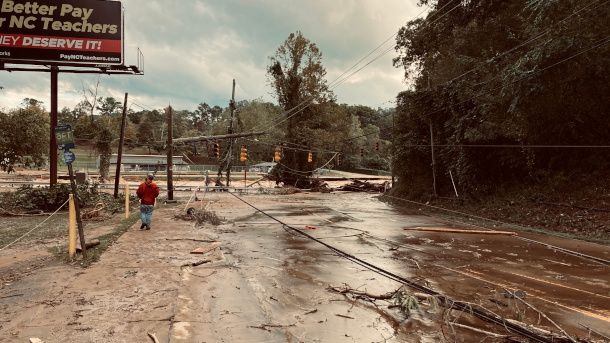
Post-Helene destruction in Asheville, North Carolina. (Photo: Bill McMannis, Flickr, CC BY 2.0)
DOERING: So, tell me a little bit more about this intensity of hurricane Milton. You know, as I understand it, the category of hurricane has a lot to do with its wind speed, but this doesn't always directly link to how much of an impact a storm can have.
SUBLETTE: Yeah, that's one of the things that meteorologists kind of poke back and forth with each other about. There's the classical Saffir–Simpson scale, one to five, five being the strongest of the storms. But you also have to think, well, when it comes ashore, what's at the shore for it to impact? Right? What is the shape of the coastline? How much property is built there, so the impacts are always a little bit different. One of the things that we really try to caution folks about is the storm surge. You know, that wall of water that comes on shore as the center of the hurricane approaches is not very well correlated to the category. I mean, if we think back to 2012 and Sandy, that was a category one storm that was losing its tropical characteristics. I mean, that's meteorological minutiae, as Jim Cantore said on the air the other day. But it was a large storm in scope and size, and when you drag that much water into a coastline, even if it's not 150 mile an hour winds, you're still pushing a phenomenal amount of water onto a coastline. The other thing about the center, and we caution people that don't, don't focus too much on the center, but the center's still important, like we saw with Milton making landfall, the center came in down near Sarasota. So, for a while, the wind in Tampa Bay was offshore, meaning going from the land to the ocean. And for a stretch, there was actually a big drop in water in Tampa Bay. So, the eye and the center, they're all very important for that storm surge flooding. The strongest winds are always around the eye, called the eye wall. But well out ahead of that, there's a lot of big impacts, heavy rain, we saw the tornado outbreak in South Florida well before the center made landfall. In fact, there was a little debate amongst us about, should we just stop saying landfall, since the impacts are six and 12 hours before the center makes landfall. Is that just a passe definition from yesteryear that we should stop using?
????️????BREAKING: Two large tornadoes from Hurricane Milton crossed Interstate 75 in the Florida Everglades around 10 a.m. EDT, moving north between the towns of Miles City and Andytown.
— AccuWeather (@accuweather) October 9, 2024
The tornado shown here was east of the first tornado and closer to Andytown. pic.twitter.com/M65dpsvgWV
DOERING: Well, tell me more about these tornadoes. Why was Hurricane Milton able to spawn multiple tornadoes, some of them deadly, as it moved across the Florida peninsula?
SUBLETTE: It is common in the outer bands of a hurricane as it's making landfall to produce tornadoes. That, in and of itself, is not uncommon. I would argue that a lot of us in the meteorological community were surprised at how many formed. That's gonna take a little more analysis as to precisely why. Just off the top of my head, we were seeing some colder air, drier air, pushing down into the Gulf off of the continent, and that was beginning to force the storm to transition, so it wasn't a purely tropical storm. And I suspect when we go back and look at the analysis, that transition will have played a role into creating an environment conducive for tornadoes in South Florida.
DOERING: We've seen something like 1.3 degrees Celsius so far in terms of average warming since the Industrial Revolution. How does the power of these storms connect back to that warming?
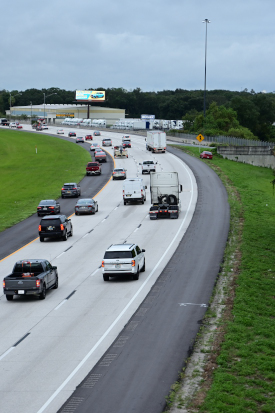
Floridians evacuate the Gulf Coast on October 7th, with the eastbound I-4 highway’s left shoulder opened for emergency use. (Photo: Andrew Heneen, Wikimedia Commons, CC BY 4.0)
SUBLETTE: Yeah, so 1.3C, which is roughly two degrees Fahrenheit, it's basically more energy into the system. Most of that energy from planetary warming is actually going into the oceans. I think that's also lost a lot. About 90% of it is actually going into the oceans, raising ocean temperatures. And it takes a lot more energy to raise the temperature of water than it does to raise the temperature of air. So, it's a phenomenal amount of energy that's going into the oceans, and you get a tropical cyclone, hurricane, over warmer water, two to three degrees warmer than it had been 60 or 70 years ago at this time. You are setting yourself for more rapid intensification and stronger storms. Most of the studies have indicated that the percentage of storms that are stronger, these Cat. threes, fours and five as a percentage of total storms, is going up. The data does not suggest that there's suddenly going to be 30 storms every year, the number of storms may be about the same, but in terms of the percentage of total storms that are more intense, that is expected to go up, and we're beginning to see that data emerge, or that signal emerge from the noise.
DOERING: Which means, of course, more need for people to prepare and heed the warnings. Now, these massive hurricanes pose a huge risk to those in their path. How well do you think that that's being communicated to local people, especially in this era of climate disinformation?
SUBLETTE: I think, having followed this for 20 years, now that it's getting better. We have issues, I think, right now, just in the communications infrastructure globally, but I think that people are starting to understand, the general populace is starting to understand what's going on. The last one to two years in particular, the oceans have been warmer than they've ever been on record, and it was like a quantum jump. When a lot of the climate science community looks at this go, what has suddenly happened? We're still trying to understand why there's this kind of quantum jump about 18 or 24 months ago in ocean temperatures. But we do know, as atmospheric scientists, things don't go up smoothly. They always kind of go up a little bit in fits and starts. They'll go up suddenly, then pause, maybe down a tiny bit, then go back up suddenly, and then pause and down a little. It's kind of a step, right? It's not smooth and linear. There's little steps, fits and starts.

Sean Sublette is a meteorologist with Sublette Weather and Consulting. (Photo: Courtesy of Sean Sublette)
And I think that's kind of what, what has happened over the last one to two years, and we're in a situation that, you know, we're not going back to the climate that your grandparents had, depending on how old you are, in the 50s and 60s, 1950s and 60s, that climate is kind of gone. I try to tell people about it this way. If you have a classical set of six-sided dice, one through six on each cube, and you just roll it, you get numbers between two and 12. Most of the time it's six, seven and eight. If you were to take that same pair of dice, remove the one on each face and put a seven there instead, and then start rolling them. Now, all your rolls are between four and 14, you still get a lot of six and sevens and eights, but now you get a 13 and a 14. What's that about? And you never roll a two or a three again, because those numbers are gone. So, the whole system is kind of shifted in that direction. You know, 80 to 90% of the time you might not notice that much of a difference, but when that outward 10% happens, it happens in a big, bad way.
DOERING: Sean Sublette is a meteorologist with Sublette Weather and Consulting. Thanks so much for joining us today.
SUBLETTE: Thank you so much for the invitation. I appreciate it.
Related links:
- Sean Sublette’s website
- InsideClimateNews | “How Climate Change Intensified Helene and the Appalachian Floods”
[MUSIC: JJ Grey & Mofro, J.J. Grey, “Lochloosa” on Lochloosa, Fog City Records]
Hiking on Wheels
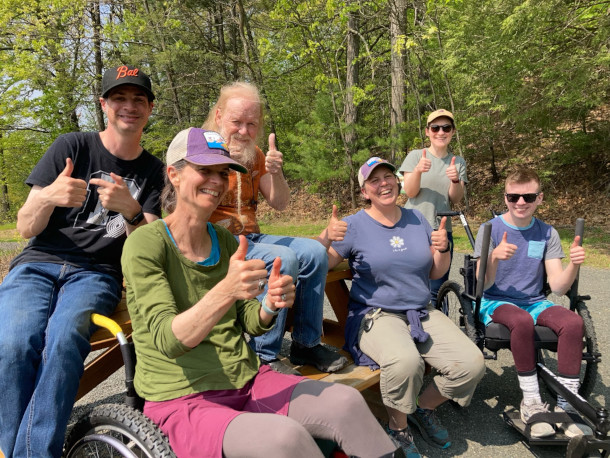
Pictured left to right: Fionn Murphy (All Out Adventures program assistant), Amy Sugihara (All Out Adventures participant), Tom Skinner (All Out Adventures participant), Karen Foster (All Out Adventures executive director), Jenni Doering, and El Wilson. (Photo: Sue Tracy, All Out Adventures)
WILSON: It’s Living on Earth. I’m El Wilson.
DOERING: And I’m Jenni Doering. El is a producer here at Living on Earth who uses they/them pronouns. But you rarely hear their voice on the show. That’s because El has cerebral palsy, or CP.
WILSON: Cerebral palsy is a disorder you’re born with that changes the way your brain controls your body.
DOERING: In addition to how CP affects El’s voice, they have a hard time balancing. So, El uses a manual wheelchair to get around.
[SFX OF EL’S EVERYDAY WHEELCHAIR]
DOERING: It’s not like a standard-issue wheelchair you’d see in a hospital or an airport. It was custom built to fit and be powered by El, who’s pretty small and lean. This wheelchair can cruise down the Boston hills, give rides to El’s fluffy orange cat, Cleo, and pop wheelies on the dance floor - to Taylor Swift, of course.
[SFX OF EL’S EVERYDAY WHEELCHAIR]
DOERING: But one thing it just can’t do is go offroad.
[SFX OF GRIT WHEELCHAIR]
DOERING: So, on this warm sunny day, El and I have come out to Mount Tom North Trailhead Park in western Massachusetts to learn how people with mobility challenges can explore the outdoors. El is going to take an offroad wheelchair for a spin, so they push out of their usual chair and with a bit of help ease into a more rugged rig called a Grit Freedom Chair.
[SFX - EL GETTING INTO CHAIR]
WILSON: Thank you.
FOSTER: You’re welcome.
DOERING: Now today we’re not just tooling around on a flat patch of dirt. We’re on a new accessible trail that heads up a hill, so El is in for a workout! But I’m confident El can do it, and the Grit chair looks up to the challenge. The tires are wider than the ones on El’s usual chair and the front wheels stick out far in front, so it doesn’t tip forward. And instead of simply rolling the wheels, El is going to push and pull two levers that allow a seated hiker to winch up a hill like this one.
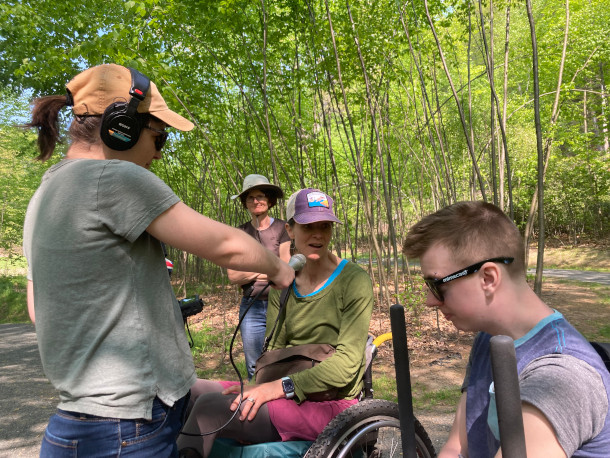
Amy got involved in All Out Adventures after a degenerative disease made typical hiking impossible. (Photo: Karen Foster, All Out Adventures)
[SFX GRIT CHAIR]
FOSTER: We might need the lesson on how to use it, actually, from Amy over there…
WILSON: Yeah.
FOSTER: because this is her chair.
DOERING: Karen Foster, Executive Director of All Out Adventures, points us toward a woman with a slight frame like El’s with brown hair and an outdoorsy vibe.
FOSTER: Hi, I’m Amy Sugihara, participant with All Out Adventures.
DOERING: Amy is maybe twice El’s age at around 50 and about 8 years ago she was diagnosed with a degenerative disease. So now she uses a manual wheelchair to get around town and the Grit chair for hiking. Like a lot of adaptive sports equipment, Grit Freedom chairs come with a hefty price tag. They cost three to six thousand or so, more than your average manual chair. The VA will cover the cost of a chair for eligible veterans. And others can apply for funding through state grants and nonprofits.
[SFX GRIT CHAIR]
DOERING: The makers of the Grit chair claim it’s twice as efficient as an everyday
wheelchair because of how it uses those levers, attached to gears that turn the wheels. It’s kind of like the difference between climbing a hill on a bike with gears versus a fixie. In fact, the Grit Chair uses bike parts so it’s much easier to repair than a typical wheelchair. But just like riding a bike… it takes practice.
DOERING: Okay, how does it feel so far?
WILSON: Hard ‘cause it’s like a muscle group I don’t use, ever.
DOERING: What you need to know is that El is an athlete who plays sled hockey, a full contact sport played on the ice that can get just as intense as the sport the Bruins play.
[SFX - EL GOING UP THE HILL]
DOERING: But this is still hard work. The crushed stone trail starts out in a meadow and soon climbs into the dappled light of the forest, giving us welcome shade. To make the trail accessible, the path is relatively even, it never gets too steep, and it has flat rest areas that follow each incline. Without accessible trails like this one, hiking would remain inaccessible for many with disabilities.
[SFX - EL GOING UP THE HILL]
DOERING: Now, you might be wondering as I did – why isn’t it paved, if it’s meant to be an accessible trail? Karen Foster says what she’s learned in her work helping people of all abilities experience the outdoors is that unpaved trails can be better than pavement in a lot of ways.
FOSTER: It’s so different being in the woods on an unpaved trail – you know, all the sensory benefits, it’s cooler, we’re in the shade.
DOERING: You feel more connected to the outdoors when you’re on a trail with a more natural surface like crushed stone.
[SFX - EL GOING UP THE HILL]
DOERING: But you also feel the burn, and in the Grit Chair, El is struggling and gratefully accepts Karen’s offer to help push. As we all take a much-needed rest on the way up the mountain, Amy Sugihara tells us she used to take on much more difficult trails than this one.
SUGIHARA: My mobility has been declining gradually over the last ten years. So, I used to be a big hiker, when I was able-bodied. And then as my mobility declined, my world just kind of closed in, you know. And I didn’t think I could hike anymore. I mean it just; it didn’t occur to me that there were ways to get out.
DOERING: Now, this might be El’s first-time hiking since their dad could give piggy back rides, but “getting out” has never been a problem. El has always had CP, and they were always told, you can do anything with the right attitude and equipment.
WILSON: Oh yeah, water skiing, rock climbing, zip lining, wheelchair lacrosse, wheelchair basketball, and sled hockey, of course.
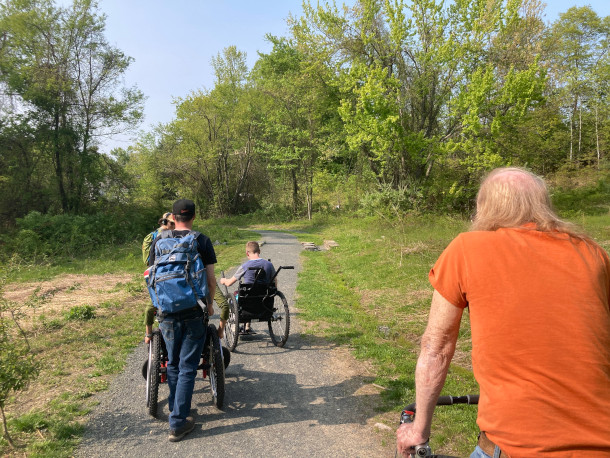
Unpaved accessible trails allow people with disabilities to access more natural landscapes than paved trails do. (Photo: Karen Foster, All Out Adventures)
DOERING: Nothing felt out of reach for El. But Amy had to adjust to a new life without the abilities she’d always taken for granted. So, at first, she felt really stuck.
SUGIHARA: I searched online looking for… Outdoor… I don’t remember what I put in exactly, probably “outdoor adventure,” and All Out Adventures popped up. ‘Cause I wanted to do something with my son who was then going into eighth grade. And it was like, “No way! Oh, my goodness!” And I called because I saw their recumbent trike program in the summer. And I thought, “Oh, my son and I could do this together.”
[SFX PHONE RINGING]
DOERING: And Karen answered the phone.
[SFX PHONE RINGING]
FOSTER: When I get to be the person on the phone that says, “Yes,” or grab the right piece of Velcro or the right bike pedals or know the piece of equipment that’s gonna work for somebody… And then I see spouses off on a bike ride together or siblings, you know, ice skating and playing chase. And when I get to see those connections in action, it’s kinda everything.
DOERING: And for Amy, being able to experience the outdoors with her family again changed her life.
SUGIHARA: It just completely opened up my world. I think we all gain a lot from being outside in nature.
DOERING: Like Amy I love to hike, and before today it had never quite sunk in for me that we don’t all have equal access to the outdoors. El says that can be a tendency for a lot of us able-bodied folks!
WILSON: All of you take everything for granted all the time!
[SFX – EL GOING UP THE HILL]
DOERING: At last, by wheel and on foot, we make our way to the top, to a clearing overlooking the Connecticut River Valley.
FOSTER: This is the view we’ve been hiking for!
DOERING: It’s so green.
WILSON: Wow.
DOERING: What do you think, El?
WILSON: Beautiful. Thank you.
DOERING: As we take in the view, we have a moment to chat with Karen about who All Out Adventures serves.
FOSTER: One of the things that people don’t necessarily understand about our programs is that only about half of our participants have disabilities. And the other half are their loved ones.
DOERING: And it turns out, there are a lot more people who can benefit from accessible trails like this one than you might think. Pregnant people, anyone pushing a stroller, elders, and more. But Karen says these trails won’t get built without able-bodied folks stepping up as allies to people with disabilities.
FOSTER: People who don’t have disabilities are more visible trail users. So, the more they advocate for the full inclusion of everybody in trail design and trail use, that’s really significant.
DOERING: Life has gotten better for people who use wheelchairs since the Americans with Disabilities Act became law in 1990. But there’s still a long and bumpy road ahead to breaking down barriers. And for El and me it’s a long road back home to Boston so we need to get going. And El’s cruise back down the trail offers a chance to test out just how fast the Grit Chair can go.
[SFX: EL GOES ZOOM]
DOERING: Having to run to keep up! But you just go! There they go, off down the hill.
[SFX OF JENNI RUNNING TO KEEP UP WITH EL]
[SFX OF GRIT CHAIR GOING DOWNHILL]
DOERING: Wow! Did you get some adrenaline?
WILSON: [LAUGHS] Uh hah, that was really fun!
SUGIHARA: You know, the more we with disabilities go out into the world and live our lives, the better it is for everybody. I think we’re all better off.
Related links:
- Learn more about the accessible trail at Mount Tom North Trailhead Park
- Visit All Out Adventures’ website
- Learn more about the Grit Freedom Chair
- Explore sled hockey
[SFX: GRIT WHEELCHAIR, crossfade with SFX EVERYDAY WHEELCHAIR]
[MUSIC: Taylor Swift, “Welcome To New York (Taylor’s Version)” on 1989 (Taylors Version) [Deluxe]]
BELTRAN: After the break, some dogs are learning to press buttons to “talk” to their owners. Stay tuned to Living on Earth.
ANNOUNCER: Support for Living on Earth comes from Friends of Smeagull the Seagull and Smeagull’s Guide to Wildlife. It’s all about the wildlife right next door to you! That’s Smeagull, S - M - E - A - G - U - L - L, SmeagullGuide.org.
[CUTAWAY MUSIC: Joey DeFrancesco, “Basin Street Blues” on Ballads and Blues, Concord Records, Inc.]
Conversations with Dogs

Although some breeds, such as poodles, learn faster than others, most breeds of dogs can learn to use AIC devices. (Photo: Patrick Wood,Comparative Cognition Lab at UC San Diego)
DOERING: It’s Living on Earth, I’m Jenni Doering.
BELTRAN: And I’m Paloma Beltran.
OWNER: So, we’ve got a treat, or we’ve got some food, which one would you like?
AIS DEVICE: Treat.
OWNER: Treat? Kenny, you know how to do sentences. Show me again!
AIS DEVICE: Kenny want… treat.
OWNER: Kenny want treat! There you go!
BELTRAN: That’s adorable Bichon Frise, Kenny, in a video on his TikTok account thetalkingdogofficial. Kenny can apparently understand specific words and even string together sentences with buttons he’s been trained to press with his paw. And he’s not alone, according to new research into word comprehension in dogs. The study, published in Plos One, recruited dog owners as citizen scientists for one of its experiments. Senior author Federico Rossano is an Associate Professor of Cognitive Science at the University of California, San Diego and joined Living on Earth Host Steve Curwood to explain.
CURWOOD: So many of us have seen those videos on Tiktok, a dog that's going over, pushing a button to say, let me out, or whatever. And the question is, how real is all of this? This is a process you wrote a paper about called augmentative species communication. So, tell me, Professor, what is augmentative species communication, and then describe for us those buttons for listeners who aren't familiar with those videos.
ROSSANO: So, there's a long history of devices that have been used with nonverbal humans to help communicate with others. This could go from pointing to letters on a keyboard to pushing buttons on which a family member might have recorded a word. So, these devices have been in use by humans for a while. And then a few years ago, people tried to use some of these devices with animals, in particular with great apes. And in recent years, not me, other people started using them with dogs. And so, what happened was that when I started seeing that this was going on in many households, and there were people using it on social media with millions of followers, I realized that there was the need of some scientific investigation on what was going on and whether these devices were valuable or just some social media fad that would quickly disappear. And that sort of is what motivated our largest project, and then the specific study that we're going to talk about today.
CURWOOD: We're talking to you because you have a fair amount of evidence that the dogs do understand when they push these buttons, that they're asking folks to either let them out or may perhaps get them something to eat. But how do you train a dog to use these buttons?
ROSSANO: Yeah, the process is called modeling, and it's quite similar to what you do, for example, with a child, where you might describe what you're doing, narrate, in a sense, and then do it. So, you might say, we're going to go outside. And you can push the button, go and the button outside, and then you open the door and go outside. Or you can say, do you want food? Push want food. And then you provide them with food. And of course, if you do it a few times, then the animal would start potentially trying to push those buttons and see what happens next and start learning an association between the use of these buttons and some effect in the world that this buttons can achieve. And sort of, that's how the learning happens, basically, by having human model, kind of narrate, in a sense, through the buttons, what they're doing and producing the appropriate behavior associated with what they're pushing. And then the dogs, ideally getting that kind of behavior response next when they push those buttons.
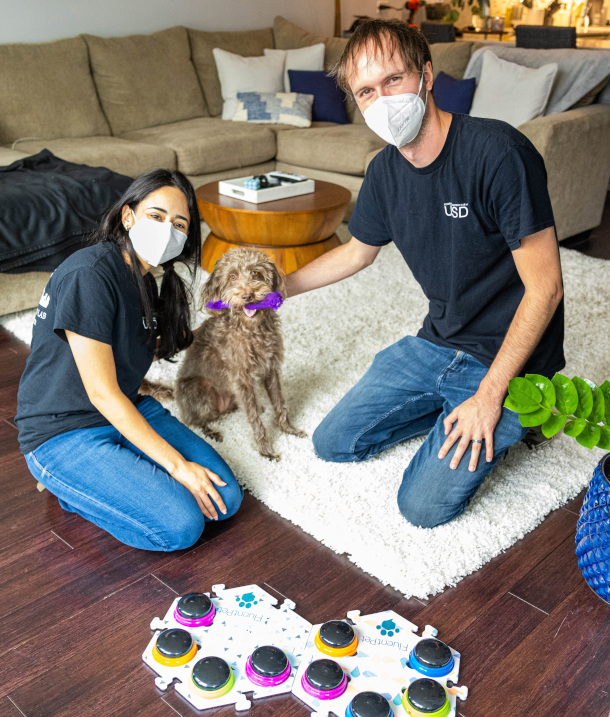
For his study, Rossano sent researchers into people’s homes to see if their dogs really understand what the words associated with the buttons meant without cues from their owner. (Photo: Comparative Cognition Lab at UC San Diego)
CURWOOD: Now, which kinds of dogs are more adept at this? Because this sounds like a measure of intelligence to learn how to do this.
ROSSANO: It could be. And yet, what I like to tell people who sign up for this study is that you don't need to have a PhD to be able to have conversations with people. So, it's not really about how many words you can get. It's more about are you motivated to interact with others and to communicate with your human? And are you willing to learn? Right? So, what we find is that the dogs who are mainly motivated by praise or play tend to learn a bit better than the ones who are mainly motivated by food. We also find that the ones who tend to be a little more on the anxious side are particularly keen on learning and using these buttons, because, as you can imagine, it can give you some more control over your environment, if you can ask for things and get things more promptly. If you are motivated to interact, if you enjoy learning things and interacting with your human, then there might be a desire to interact also this way. If you are of a breed that is kind of designed to mainly keep people away from your home or be a watchdog in your yard, probably you don't really want to have a lot of chats with humans, you might actually try to keep them away. So, you might not be the best choice for trying to do this training. But again, it doesn't mean that you cannot learn it. It's more like maybe you're not necessarily super motivated.
CURWOOD: How applicable is this to cats?
ROSSANO: It depends a lot on your cat, and also on your patience with your cat, but if they're willing to participate and engage, they're smart animals, and if they can use it to get stuff, they will use it. It's possible. It's definitely possible.
CURWOOD: Professor Rossano, some people say that dogs have the intelligence of, say, a two-year-old or even a two and a half year old human. What's your assessment of that understanding?
href="https://www.tiktok.com/tag/talkingdogsoftiktok?refer=embed">#talkingdogsoftiktok #dogtok #smartdog ♬ original sound - The Chatty Lab
ROSSANO: I honestly think they are quite right. I work with people who make claims that dogs were more like infants, so more like, you know, nine months old or 10 months old, and there was very good evidence for that about 15 years ago, but in the last 15 years, a lot of work has shown us that they can reason about human minds and others. They pay attention to human communications in remarkable ways, and they appear to have the linguistic competence of what would be, at the very least, a toddler, right? So many of these dogs can learn several dozens words. And even in our study, we have about 60 dogs that are more than 100 buttons that they're using on a regular basis. So, you could imagine, once you get to a vocabulary like that, it is indeed analogous to having basically a two-year-old trying to communicate with you.
CURWOOD: Now, one of the concerns with some of these studies regarding animal communication is the so-called Clever Hans effect. Tell us about Hans and the effect that people are concerned about.
ROSSANO: So, Hans was a famous horse that at beginning of the 20th century was famous because people thought it was capable of making mathematical calculations. The reality was that what would happen was that its owner would say something like four plus three, and then Hans was hit his hoof on the ground until would hit seven. And people thought, “Oh, this is amazing. This animal can do it,” until a psychologist observed the process and realized that what Ans was actually doing was paying attention to the faces of its owner first, and if not its owner of the people around him, and when they would see them smile, because it would reach the correct answer, it would just stop hitting his hoof on the ground. So, it was basically particularly capable of processing behavioral cues from humans, and by looking at facial expression was knowing what to do.
This is an important constraint, because, of course, one possibility when we talk about dogs understanding words is that maybe all they pay attention is, for example, intonation. They don't really understand the word. They just pay attention to how you say it, or they pay attention to behavioral cues. So, for example, if I say outside, but what I say, I'm also putting my shoes on or my jacket on, or I'm moving close to the door, we don't really know if the dog is really paying attention to the word, per se, or is also seeing all these other behaviors associated with it that help you figure out, infer that this is actually what's going to happen next. So, we needed to do studies that would try to tease this apart and show that, no, they're really paying attention to the words and not just to the behavioral cues.
CURWOOD: So obviously you wanted to correct for that possibility. What did you do?
ROSSANO: So, what we did is we sent our own experimenters into people's homes. Basically, we had two researchers going to people's homes, one would cover the buttons with stickers so that you wouldn't be able to see what were the signals on the button. And then we're going into another room with the owner, so that the owner would not be in the same room as the dog. And then the second experimenter would be wearing headphones and sunglasses so that you could not just read from the eyes what was going on, and could not hear what button they were pressing, and they couldn't see which one it was, because there were stickers on them. So, they would push the button and then stand still, and the dog would just respond in some way. And then after a certain amount of time, they would push another button and see what the dog would do. And then what we would do is we would have researchers that were not in the household watch video clips without the behavior of the experimenter pushing button, so just watching the response of the dog, not in the same order in which it happened, so that you couldn't just figure out maybe it's the last trial, so it must be this thing. And annotate what they saw in terms of behaviors, and basically predict what was the concept associated with it. The idea was, if I push the button outside, and you understand that, the contextually appropriate response would be for you to move towards the door to go outside. If I push a button, play, then you should look for some toy. If I push the button, food, you should go where food usually is kept or where you receive food. And if you have an appropriate response, contextual, appropriate response, then we can assume that you understand what this word is supposed to elicit as a next action. And that's sort of what we did, and we found evidence that this is indeed the case for the dogs that participate in our study.
CURWOOD: In your studies, what do you find in the way of emotions that dogs can convey? How might they use these buttons to say how they're feeling?

Humans with speech disabilities often use Augmentative and Alternative Communication (AAC) programs to communicate — most commonly via tablet apps like those on an iPad. (Photo: 彭家杰,Wikimedia Commons, CC BY-SA 4.0)
ROSSANO: So, this is work in progress, and of course, as a scientist, I always need to be careful about the claims I make. So, there's clear evidence that these dogs are pushing buttons associated with emotions. Those things will be things like concerned, mad, happy. And some people have asked me, is like, how is that even possible? But again, I have two little children, and I see how my two-year-old is learning emotions and is at school, they show him faces with smiles and frowned faces. And then it's like, happy face, sad face. And when he sees people, he comments on happy or sad based on the mouth position and the rest of the facial expression. So, in many ways, at the beginning, also humans learn, by ways, like you start to associate certain facial expressions with the label, right? It's like happy or sad or concerned or frustrated. And so, what we see is that these animals are using these buttons to label their emotions. For example, one of the things we have seen very often is like, if outside is very loud or if it's hot, they might just complain that they are unhappy. If they're not getting the food that they want, especially if they ask for food and they don't get it, they say they're mad and they're upset. So, I think there's a lot more work that needs to be done, but there are several reasons to believe that there's much more depth and knowledge in these animals than we give them credit for.
CURWOOD: Somebody listening to us, or maybe they've seen the videos online might want to try it at home themselves. To what extent is it safe for people to do this at home themselves, and if so, what are ways that they might get started?
ROSSANO: Yeah, so it is absolutely safe to do it at home yourself. So, there's several brands that you can find online. I don't produce them. I don't sell them. I don't make any money out of this. So, I'm just studying the process, but there are several brands out there. They're not particularly expensive. And you can start with, really just three or four buttons, and not all at the same time. It can start with one. A lot of people start, for example, with a button outside. This becomes part of your routine. Before they go outside, you just push the button outside, and then you go outside and you see if the dog starts pushing for it, and then you take them out. And then you might add another button to the process, and maybe it's play or food or some other buttons along the way. There's a lot of participants, a lot of people out there that really have four or five buttons, and so just some basics of like, I want food, I want water, I need to go pee, and maybe I want to play. That's sort of all you need.
CURWOOD: So, tell me about your hopes of how we could use augmentative interspecies communication to improve the lives of pets and people.
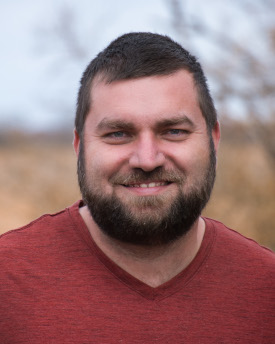
Federico Rossano studies the differences between animal, child, and adult human cognition. His recent work focuses on how pets communicate. (Photo: Comparative Cognition Lab at UC San Diego)
ROSSANO: So, I believe there are many ways in which they could potentially help and at the same time, again, more work is needed. Some of the ways in which I believe they could improve our understanding and the lives of pets is that if we can show systematically that these animals indeed have the intelligence or the communicative abilities of a three-year-old, then you can imagine that the way we interact with them, the way we take care of them, the way we decide, for example, how many hours a day are we willing to leave them alone, or whether we can leave them in shelters and so on and so forth? You know that could be affected. If they can find a way to communicate about pain, and we can then bring them to the vet much earlier, this would potentially extend their life, which, of course, would be beneficial for them. And the general impression is that the use of this devices is particularly beneficial for anxious dogs, for dogs that experience anxiety, which often comes from the difficulty of controlling and predicting the environment around you. And so even just an improvement in terms of control over your environment and the voice that can be heard by your owner, then you're making their lives better. So, at the very least, I think it's gonna improve pets lives. Owners are reporting benefits in terms of improved bonding with their pets because of the training, really, because of the training, obviously, communication leads to improved bonding, as we know. But on the other end, I do think that the very effort you put into doing the training, trying to do something together, it's like working on a project together, creates a bonding experience that I think makes you feel closer.
CURWOOD: What's been the most surprising of your findings?
ROSSANO: There's one thing that had always fascinated me and is the fact that a lot of research with animals is using food as a reward, and it's also focusing on them understanding names or labels of artifacts, objects. And one of the thing I'm seeing with this dogs is how often they actually are asking or pushing the buttons of a person or another animal, another pet in the household that when it's not present, and asking, where are they or what's going on? And to me, this is critical, because while we think that, you know, even in humans, the most important thing is to learn names of objects and names of verbs, the reality is that they are social creatures, just like we are social creatures. And of course, for humans, the first words you learn are mom and dad. Those are the things you care about. And for a dog, when you're not there, they wonder, where are you? To me, was a good reminder of not obsessing over names of toys, but maybe thinking more about what are the social things that a social creature would care about, which is also why play might be more important than other activities that we think are necessary.
BELTRAN: That’s cognitive scientist Federico Rossano of UC San Diego speaking with Living on Earth Host Steve Curwood.
Related links:
- Find out if you and your pet can participate in Rossano’s studies.
- Learn more about sound board AIC devices.
- Read Rossano’s recent study about AIC communication and dogs.
[MUSIC: Funky Times, Jonathan Wilson, “Groove Window” Single, K-Mountain Productions]
DOERING: Living on Earth is produced by the World Media Foundation. Our crew includes Naomi Arenberg, Kayla Bradley, Josh Croom, Daniela Faria, Swayam Gagneja, Sommer Heyman, Mark Kausch, Mark Seth Lender, Don Lyman, Nana Mohammed, Aynsley O’Neill, Sophia Pandelidis, Jake Rego, Andrew Skerritt, El Wilson, and Jolanda Omari.
BELTRAN: Tom Tiger engineered our show. Allison Lirish Dean composed our themes. You can hear us anytime at L-O-E dot org, Apple Podcasts and YouTube Music, and like us, please, on our Facebook page - Living on Earth. We tweet from @livingonearth. And find us on Instagram @livingonearthradio. And you can write to us at comments at loe dot org. Steve Curwood is our Executive Producer. I’m Paloma Beltran.
DOERING: And I’m Jenni Doering, Thanks for listening!
ANNOUNCER: Funding for Living on Earth comes from you, our listeners, and from the University of Massachusetts, Boston, in association with its School for the Environment, developing the next generation of environmental leaders. And from the Grantham Foundation for the protection of the environment, supporting strategic communications and collaboration in solving the world’s most pressing environmental problems.
ANNOUNCER 2: PRX.
Living on Earth wants to hear from you!
Living on Earth
62 Calef Highway, Suite 212
Lee, NH 03861
Telephone: 617-287-4121
E-mail: comments@loe.org
Newsletter [Click here]
Donate to Living on Earth!
Living on Earth is an independent media program and relies entirely on contributions from listeners and institutions supporting public service. Please donate now to preserve an independent environmental voice.
NewsletterLiving on Earth offers a weekly delivery of the show's rundown to your mailbox. Sign up for our newsletter today!
 Sailors For The Sea: Be the change you want to sea.
Sailors For The Sea: Be the change you want to sea.
 The Grantham Foundation for the Protection of the Environment: Committed to protecting and improving the health of the global environment.
The Grantham Foundation for the Protection of the Environment: Committed to protecting and improving the health of the global environment.
 Contribute to Living on Earth and receive, as our gift to you, an archival print of one of Mark Seth Lender's extraordinary wildlife photographs. Follow the link to see Mark's current collection of photographs.
Contribute to Living on Earth and receive, as our gift to you, an archival print of one of Mark Seth Lender's extraordinary wildlife photographs. Follow the link to see Mark's current collection of photographs.
 Buy a signed copy of Mark Seth Lender's book Smeagull the Seagull & support Living on Earth
Buy a signed copy of Mark Seth Lender's book Smeagull the Seagull & support Living on Earth

